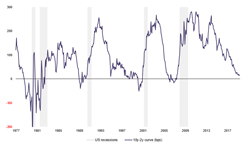Wealth Management: Strategy blog – A ceiling, not an abyss?

Strategy team - Kevin Gardiner and Victor Balfour (Wealth Management)
There is still little sign of US or global recession on the immediate horizon.
The US manufacturing ISM survey - perhaps the single most useful indicator, though not infallible - remained comfortably above neutral in March. Indeed, in place of an expected flat reading, the composite index actually rose on the month, with the forward-looking 'new orders' component leading the way.
This news followed hard on the heels of a significant rebound - back into expansionary territory - in China's manufacturing PMI, and an outlandish gain in the UK's.
Continental Europe's manufacturing surveys continue to lag, especially Germany's. With the rest of the world doing a bit better, it is getting more difficult to attribute this to the impact and anticipation of trade tensions. Perhaps the difficulties faced by the autos sector - which affect Germany disproportionately - are having a bigger (and structural?) impact than we'd realized.
Whatever its cause, German manufacturing is not yet weak enough to deliver a major setback to global business. Meanwhile, Europe's service sectors (and labour markets) seem to be a lot more resilient.
Admittedly, recessions do have a habit of sneaking up on us. US retail sales have cooled by more than the manufacturing ISM, and we should still expect to see soft first quarter US GDP growth (perhaps 1.5% annualised). But there have been some temporary factors at work: the partial government shutdown, an inventory cycle and (seasonal adjustment notwithstanding) the weather. The ISM survey suggests a more meaningful downturn is not at hand.
This conclusion seems to be at odds with the message supposedly coming from the bond markets, where yields have fallen in recent months. The yield curve - the gap between long-term and short-term yields - has flattened, and on some measures turned negative (or become 'inverted'), and market lore tells us that this is a good guide to an approaching recession.
Otherwise sensible commentators often attribute an almost mystical potency to the curve. James Carville, an adviser to the Clinton White House, recognised this when he quipped: "I used to think that if there was reincarnation, I wanted to come back as the pope or as a .400 baseball hitter. But now I would like to come back as the bond market. You can intimidate everybody."
A flatter or inverted curve has preceded most recent recessions - but not always closely enough for it to have been a useful trading signal. And for market analysts to unquestioningly accept the apparent economic predictions of the markets themselves - which they are presumably interested in primarily because of what those predictions might tell them about the markets! - might be a bit of a cop-out.
The US yield curve (10-year - 2-year yields, bps) and recessions:
Click the image to enlarge
There is no special knowledge out there to which the bond market has unique access. And with the Fed still holding a big chunk of the US market, the 'signals' that market is sending may be (even) less clear than usual.
Rather than seeing low bond yields as a harbinger of approaching recession, we'd see resilient data like the ISM as a harbinger of an eventual rebound in bond yields.
Barring a particularly sudden slump in April-June, then, this summer the current US expansion seems likely to enter the record books as the longest ever, nudging ahead of the decade-long upswing of the 1990s. Needless to say, few pundits predicted this back in March 2009 - rather the opposite. And economists have been selling it all the way up. It may turn out to have been the most under-appreciated cycle as well as the longest.
Ongoing growth alongside continuing low interest rates has given investors a very clear steer. All macro watchers needed to do was to go long of stocks and stay there. But can global stock markets continue to deliver the 14% annualized US dollar returns seen in the last decade?
We doubt it. Long-term headroom has likely fallen as valuations have rebounded from being cheap in 2009 to being mildly expensive today. On a shorter-term perspective, profits growth has to slow more sharply than economies, which even now investors may not have fully digested (after growing by a quarter in 2018, US earnings could crunch to a standstill for a while). And if we're right about the economy, the Fed may eventually return to hiking US short-term interest rates later this year.
But long-term projected stock returns still remain above prospective inflation rates - and if a big recession is not yet at hand, a more dramatic short-term reversal in profits and markets still feels unlikely. We think we're running out of headroom, not peering into an abyss.
Disclaimer
Past performance is not a guide to future performance and nothing in this blog constitutes advice. Although the information and data herein are obtained from sources believed to be reliable, no representation or warranty, expressed or implied, is or will be made and, save in the case of fraud, no responsibility or liability is or will be accepted by Rothschild & Co Wealth Management UK Limited as to or in relation to the fairness, accuracy or completeness of this document or the information forming the basis of this document or for any reliance placed on this document by any person whatsoever. In particular, no representation or warranty is given as to the achievement or reasonableness of any future projections, targets, estimates or forecasts contained in this document. Furthermore, all opinions and data used in this document are subject to change without prior notice.
